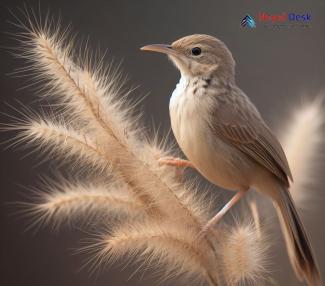Nestled within the diverse landscapes of Nepal, the Common Babbler (Turdoides caudata) is a fascinating bird species that holds a special place in the hearts of avid birdwatchers and nature enthusiasts alike. With its distinctive appearance and unique vocalizations, this small, social bird has captured the fascination of many who have had the privilege to witness it in its natural habitat. In this article, we will delve deeper into the world of the Common Babbler, exploring their habits and habitats while shedding light on why they're such an essential part of Nepal's rich biodiversity.
Distinctive Characteristics: Form Meets Function
The Common Babbler is a small, brownish-grey bird with a length of about 23-28 cm, making it seem unassuming at first glance. However, upon closer inspection, one can admire its striking features such as its long tail, strong legs, and feet that are perfectly adapted for its terrestrial lifestyle. The plumage of the Common Babbler varies from lighter shades on the underparts to darker shades on the upper parts, providing effective camouflage while foraging on the ground.
Chatty and Social Behavior: Nature's Living Soundtrack
One feature that instantly sets the Common Babbler apart from other bird species is their intriguing social behavior and vocalizations. As their name suggests, babblers are known for their constant chattering and communication amongst themselves. They live in groups of up to 15 individuals called 'parties', creating a vibrant acoustic ambiance wherever they reside. Their melodious calls serve various purposes, including warning group members of potential threats or letting them know about nearby food sources.
Preferred Habitats: A Niche in Nature’s Tapestry
The versatile Common Babblers are found across various habitats in Nepal – from subtropical forests to scrublands and even village outskirts. They have a penchant for foraging in open areas with dense undergrowth, making Nepal's diverse natural spaces a welcoming haven for them. These birds play a crucial ecological role as well, dispersing seeds and controlling insect populations, thus contributing to the overall health of their habitats.
Conservation Status and Efforts: Safeguarding Our Feathered Friends
Despite being deemed a species of least concern by the IUCN Red List, the Common Babbler still faces threats from habitat loss due to deforestation and urbanization. It is essential to raise awareness about these birds and invest in conservation efforts that preserve their habitats. In Nepal, this includes supporting local organizations working tirelessly to protect biodiversity and developing eco-friendly tourism initiatives that minimize human impact on nature.
In conclusion, the Common Babbler is more than just another bird species found in Nepal; it is an integral part of the country’s diverse ecosystem. Their distinctive appearance, social behavior, and unique vocalizations make them a joy to observe for both seasoned birdwatchers and casual nature lovers alike. As we learn more about these fascinating birds, we must also commit ourselves to their conservation for future generations to cherish their harmonious presence in Nepal's natural landscapes.




